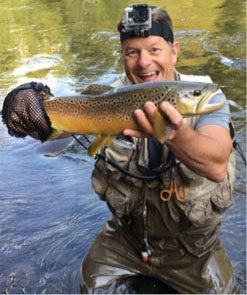Have you ever wondered if there was a fly fishing technique that would dominate the waters? Learning to fly fish was a tough experience. My father-in-law taught me how to fly fish four years ago, by using the standard nymphing technique with a strike indicator. We didn’t want to change our technique, because that would cost money for a new setup, and nobody likes change.
My father-in-law and I have switched to a technique called Czech Nymphing, also known as Euro Nymphing. The number of fish we have landed has multiplied three-fold, and the pictures above are a testament to our credentials. With a strike indicator, there is a delay from the point when the fish takes the fly, when you see the strike, and when you set the hook. Czech nymphing is a high sticking technique (similar to tenkara) that does not use a strike indicator. This technique involves primarily roll casting, where you match your rod with the drift of the current, while keeping the line taut. A 10’ to 11’ 2wt or 3wt rod is recommended. At the end of your fly line, you tie a Euro Leader on. You can either construct or buy a Euro Nymphing leader. This has sight line that allows you to see if you have a strike or not. At the end of the leader, you will tie on a tippet ring. From there, you will tie about a 4 to 5 foot length of 4x or 5x tippet. At the end of the 4x or 5x tippet, tie on another tippet ring. At this final tippet ring, you will have two tippets. The first tippet will be about 8 to 12 inches of about 5x (obviously water condition/clarity dependent). This will be your heavy lead fly. Then tie another tippet on the same tippet ring, but longer, approximately 24 inches of a lighter tippet, like 6x. This is your dropper fly, which is your smaller and lighter fly. Always use fluorocarbon tippet for better results.
The PROs to this technique include: roll casting, no line mending, and drag free presentation. The flawless presentation allows the fly to be placed on the trout’s nose. This method allows you to get down to the fish or as I like to call it “the fish’ kitchen.” Now, without a strike indicator, you are relying more on feel and the sight line, which is crucial to be taut. This gives you a direct line to the fish. So, there is no delay between strike and hook set- it is almost immediate. Now, I would be lying if I said there were no CONS to this technique. The biggest CONs to this technique are snags and losing flies, but using jigged fly hooks helps prevent this. Euro Nymphing is a deadly technique, when used by a skilled fly angler. The learning curve is relatively quick, so give it a shot. You will not be disappointed. Tight lines!
Though he’s from Washington State, TeJay Espe is a cool cat. He is an all-around outdoorsman. He isn’t afraid to admit, that as an Army Aviator, he still enjoys working out while listening to some good ol’ Taylor Swift hits.
